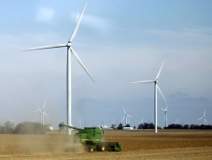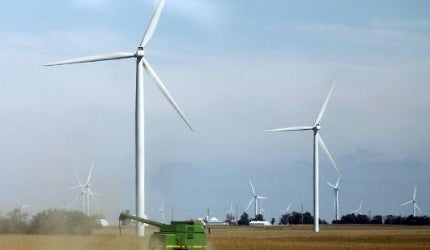

The Buckeye Wind Project is planned to be constructed over a two-phase installation of commercial wind turbines in Champaign County of central Ohio. The two phases of the project, Buckeye I and Buckeye II, wind farm are being developed by EverPower Wind Holdings, which is a subsidiary of EverPower Renewables (Ever Power).
As well as Buckeye I and Buckeye II, EverPower is also developing the Hardin Wind Project in Hardin County, Ohio.
Construction of both phases of the Buckeye wind project is expected to start simultaneously in 2013. The total project cost is estimated to be more than $400m. Nearly 600 construction jobs and 38 permanent jobs are expected to be created by the project.
With a total of 110 turbines spread over six townships (Goshen, Rush, Salem, Union, Urbana and Wayne), the project is expected to generate between 216MW to 294MW of power, which is enough for 60,000 households.
The project’s output is the equivalent of saving more than 350,000t annual greenhouse gas emissions.
Buckeye wind project approval and delays
The Ohio Power Siting Board (OPSB) approved the Buckeye Wind Project in March 2010. However, the project’s implementation was delayed due to opposition from various affected corners, as well as a local group of citizens.
As of December 2012, the phase I of Buckeye Wind Project was in its final stages of the permitting. The application for the second phase of Buckeye Wind Project (Buckeye II) was filed in May 2012 and its approval is expected in early 2013.
Plant details of Buckeye wind farm
Related project
Lower Snake River Wind Farm, Garfield County, US
Lower Snake River is the largest wind farm built to date in Washington. The 1,432MW wind farm spans across the Garfield and Columbia counties.
The Buckeye I wind farm will be installed with 54 wind turbines and will spread over 10,000 acres of leased land. Whereas the proposed Buckeye II wind farm will be installed with up to 56 wind turbines and will spread across 13,500 acres of land adjacent to Buckeye I wind farm.
The Buckeye I wind farm will have an installed capacity of 175MW and generate 125MW annually. The installed capacity of Buckeye II wind farm will be between 91MW and 171MW.
Each turbine and tower will have a height of 492ft and 328ft respectively. The rotor set on top of each tower will accommodate three turning blades.
Each turbine will generate 2.5MW of electricity. As of December 2012, the type of turbines was yet to be chosen. However, the project has been designed to suit either the Repower MM925 turbine or Nordex N100 or N90 turbine types.
RePower, GE, Vestas, Nordex and Gamesa are being considered as the potential turbine manufacturers for the wind farm project.
Each turbine, measuring 500ft in height, will generate 2.5MW of electricity, sufficient to power 600 to 750 homes.
Financing for the Buckeye wind farm
A grant of $3m was sanctioned to EverPower for the first phase of Buckeye wind project under Ohio’s Wind Production and Manufacturing Incentive Program. The project will also receive 1¢/kWh and an additional 0.2¢/kWh if the plant is installed with Ohio-made wind turbines under the incentive programme, which is promoted as part of Ohio’s alternative energy portfolio standard.
Financial backing for the project has also come from Guy Hands’ private equity arm, Terra Firm.
Grid network for Buckeye wind Farm
Electricity generated from the wind farm will be fed to the transmission system of PJM Interconnection through the Dayton Power & Light network (DPL). From there, the power will be supplied to Urbana, Mechanicsburg and Darby via a 138KV PJM transmission line.
PJM Interconnection is a regional transmission organisation that coordinates the transmission of electricity from the power plants to several states in the US.
Future of windpower in Ohio
The Ohio state is one of the largest producers of electricity and the fourth largest consumer of coal in the US. In 2008, Ohio produced 86% of its electricity from coal-fired plants and the remaining 14% from nuclear and renewable sources. The installed electricity capacity of Ohio stood at 38,000MW for the same year.
Electricity generation is a major source of air pollution and greenhouse-gases. But the demand for electricity continues to grow day by day. Generating electricity from clean renewable energy has emerged as the overriding solution to this problem. Ohio is not behind in seizing the trend of renewable energy production.
Ohio state, which produces most of its electricity from coal-fired plants, implemented a new alternative energy portfolio standard in May 2008. The standard requires 25% of the electricity sold in the state to be generated from alternative energy sources by 2025 and at least half of it to be generated through wind.
Ohio possesses good conditions for wind turbines. As of 11 February 2010, the state had total windpower potential of 55GW of onshore wind with a generating capacity of 152TWh a year. As of May 2010, Ohio had used only 1.8% of its total windpower potential and ranked 27th in the US, with 7.2MW of wind energy production.
However, in 2011, Ohio emerged as the fastest growing state for new installations.
With the potential for new wind farms, the wind energy industry of Ohio has seen significant growth inrecent years. The state’s wind industry now has more than 50 wind energy manufacturers and support 3,000 to 4,000 jobs in operations, maintenance, construction and manufacturing.


